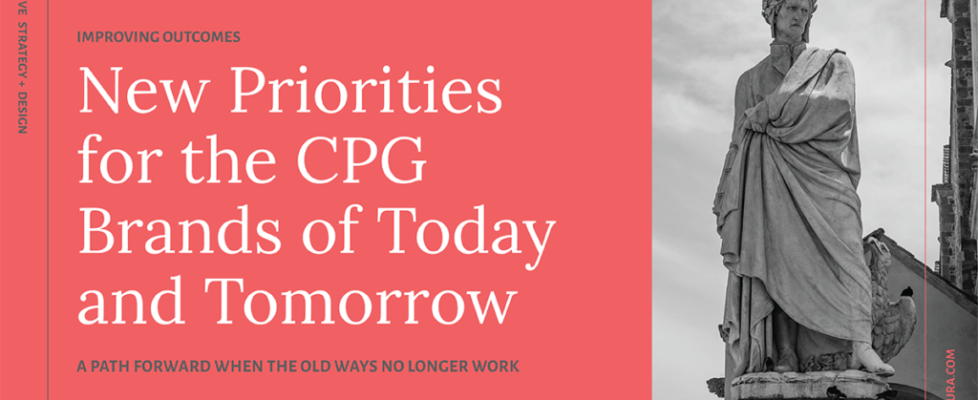New Priorities for the CPG Brands of Today and Tomorrow
A path forward when the old ways no longer work
“In the middle of the journey of our life, I found myself within a dark wood, where the straight way was lost.” Rather than describing Dante’s protagonist, this could just as easily describe the state of a large portion of CPG brands today. For the last few years, it has been tempting to point to the black swan event of a pandemic as the primary driver of the uncertainty and volatility they have been facing—as they’ve witnessed tried and true strategies for growth to fail to deliver as expected. But in adjusting to this new endemic reality, it is becoming clear that our volatile and dynamic landscape is not just the result of the pandemic but of technological changes, cultural shifts, and a fundamental evolution in commerce itself. While we may see some version of a post-pandemic normal, the likelihood that brands can retreat to the old model where incumbents with mass-marketed, acceptable products, fueling growth and expansion, seems vanishingly low. The bright side of all this is that the straight path—the core strategies that enable brands to succeed in this new reality—is quite plain to understand, if not implement, after all of the jargon and trademarked processes are stripped away.
Additionally, some of the fundamentals remain unchanged. Strong, established brands can still deliver value through commercialization efficiencies or by representing quality associated with that endurance. And without a differentiated proposition that aligns with emotional needs and values that can be communicated effectively—if people can ask ‘why should I care?’ and not receive a compelling and believable response—you have more significant problems to address than the shifts in thinking I’d suggest below.
Because whether you are a large, established brand with long-standing equity, or a completely new entrant, if your foundation is solid, the strategies guiding the focusing of resources and attention driving growth today are the same.
1. Put Portfolio Strategy First
We need to develop brands with a niche focus to meet emerging consumer needs. A single well-managed brand relying on extensions, ad spend, and partnerships with retailers, are no longer able to dominate its categories. A well-thought-out portfolio strategy effort can help guide innovation, define boundaries and enable a range of brands and expressions that articulate unified values and vision. Fleshing out a portfolio strategy is much more difficult (and expensive) to do after ad-hoc proliferation. By putting in the effort upfront, brands can set themselves up for success for years and create a solid foundation to adjust and amend if needed. A well-built portfolio strategy will not only shore up existing brands but also identify opportunities and areas for growth.
2. Prioritize Rapid Brand Development
Category fragmentation is here to stay. Because tastes and behaviors in fast culture evolve, venture capital elevates the punching power of new or resurgent brands, and precision continues to win over broad reach in our increasingly hyper-connected culture; the speed of development is critical. Established brands need to make the processes for development, acquisition, and incubation of nascent brands core capabilities, and new entrants should seek to build this into their fabric from day one.
3. Make Innovation an Integrated Effort
The divisions between R&D, Innovation & marketing are becoming foggier and greyer every year as CPG companies search for relevance bound by speed to market in a competitive and fluid landscape. Companies need to structure their expectations and rewards systems to enable more seamless collaboration and experimentation to enable quick development timelines. By pushing against these traditional silos or organizing your company from the outset to collapse them into a single multi-disciplinary practice, you can move with greater velocity and relevance.
4. Learn Organically
Traditional research methods used for validation have never lived up to the certainty they promised. At best, monadic quali-quant testing offers probabilistic measures within a specific framing—often coopted to justify a position taken by some stakeholder—and at worst, it is slow, expensive, and misleading about the real-world application. To increase agility, actionability, and confidence in their learnings, brands can leverage many fast and cheap digital tools geared toward measuring what people do vs. what they say. And even though Tim Brown has been talking about it for 20 years now, we could move with improved speed and confidence in our direction if we looked at brands as an evolving expression—something of a prototype to test, learn from and revise in an unending cycle of improvements.
5. Rethink Equity Frameworks
Hammering people over the head with consistent brand ‘impressions’ to link a particular hue, icon, or verbal cue isn’t compatible with the world of today. Not every space can be curated. Desire and delight look different in different contexts to different self-defined culture groups that have nothing to do with demographics. For brands to be relevant in the spaces they need to play; they need to be flexible and fluid without losing their true identity. Brands can create a space for meaning and conversation, but it’s chasing windmills to think they can control the content of every conversation or just what they will mean to everyone involved.
6. Connect to Culture
Dig deep and connect authentically to those minute cultural forces, or don’t do it. The zeitgeist is a robust foundation to build from, but it’s like surfing. You don’t try to ride every wave, and when the right one comes, you already need to be paddling hard if you don’t want to be passed over. By teaching your biggest fans that you will listen and respond to their needs through long-term relationships, you will be presented with powerful opportunities with enough time to react and start paddling if you weren’t already.
7. Co-create Value with Your Tribe
Brands need to reframe how they think about their role as citizens within a culture. CPG companies need to shift their thinking from product to service. Exist to provide value and recognize that any product you sell is only a tiny part of that. Your content, perspectives, communities you support and enable, and the role that the brand plays in those is just as important in manifesting your reason for being as what you sell. The goal should be to create communities with shared values and interests and show up authentically for your tribe where it makes sense. And it won’t make sense everywhere to everyone, but loyal fans are significantly more valuable than satisfied customers. By involving your most loyal fans in the creation of your brand’s story, you can uncover real opportunities and create an engine for innovation.
So whether you are large or small, new or old, loved or as yet unknown, be confident in losing that framing. The more useful heuristics are fast vs. slow, future-focused vs. antiquated, fluid vs. inflexible, or connected vs. out-of-touch. Any CPG company, if it wants to have any standing with the community of tomorrow, can—and should—embrace these priorities. Because the future is for the fast, forward-looking, flexible, culturally connected brands, who co-create value with their tribe.

